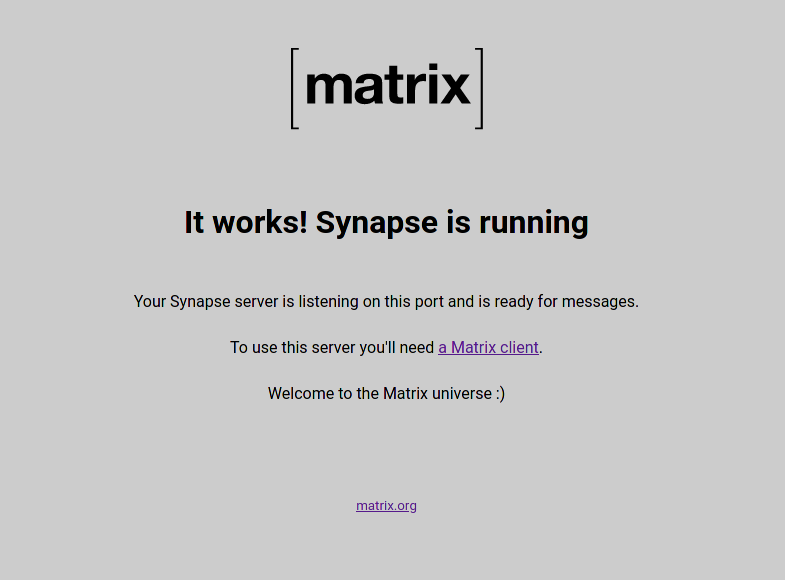Synapse is the reference implementation of the Matrix protocol, a decentralized communication standard for instant messaging and VoIP. It serves as the server software for the Matrix communication network, allowing users to communicate seamlessly across different platforms and services in a federated and open manner. Synapse supports end-to-end encryption, user authentication, and the storage and retrieval of messages in a distributed and secure way.
In this repository we want to run a synapse matrix on kubernetes in the following part.
- Before starting, I have deployed a Kubespray on two servers as master and worker. (You can use the Kubernetes you want)
- we assuming, we've set up a domain and two subdomains for the Synapse service.
- domain: example.com
- subdomains: matrix, turn
- Basic Knowledge about Kubernetes and Linux itself
curl -o /tmp/helm.tar.gz -LO https://get.helm.sh/helm-v3.10.1-linux-amd64.tar.gz
tar -C /tmp/ -zxvf /tmp/helm.tar.gz
mv /tmp/linux-amd64/helm /usr/local/bin/helm
chmod +x /usr/local/bin/helm
check helm version
helm version
version.BuildInfo{Version:"v3.10.1", GitCommit:"9f88ccb6aee40b9a0535fcc7efea6055e1ef72c9", GitTreeState:"clean", GoVersion:"go1.18.7"}
The controller ships as a helm chart, I grab version 1.9.5 as per the compatibility matrix.
helm repo add ingress-nginx https://kubernetes.github.io/ingress-nginx
helm search repo ingress-nginx --versions
From the app version I select the version that matches the compatibility matrix.
NAME CHART VERSION APP VERSION DESCRIPTION
ingress-nginx/ingress-nginx 4.9.0 1.9.5 Ingress controller for Kubernetes using NGINX a...
Now we can use helm to install the chart directly
CHART_VERSION="4.4.0"
APP_VERSION="1.5.1"
mkdir ./kubernetes/ingress/controller/nginx/manifests/
helm template ingress-nginx ingress-nginx \
--repo https://kubernetes.github.io/ingress-nginx \
--version ${CHART_VERSION} \
--namespace ingress-nginx \
> ./kubernetes/ingress/controller/nginx/manifests/nginx-ingress.${APP_VERSION}.yaml
# Deploy the Ingress controller
kubectl create namespace ingress-nginx
kubectl apply -f ./kubernetes/ingress/controller/nginx/manifests/nginx-ingress.${APP_VERSION}.yaml
kubectl create namespace ingress-nginx
kubectl apply -f ./kubernetes/ingress/controller/nginx/manifests/nginx-ingress.${APP_VERSION}.yaml
kubectl -n ingress-nginx get pods,svc
NAME READY STATUS RESTARTS AGE
pod/ingress-nginx-admission-create-q4b2f 0/1 Completed 0 21m
pod/ingress-nginx-admission-patch-j67vn 0/1 Completed 0 21m
pod/ingress-nginx-controller-76df688779-4ph6z 1/1 Running 0 21m
NAME TYPE CLUSTER-IP EXTERNAL-IP PORT(S) AGE
service/ingress-nginx-controller LoadBalancer 10.233.7.145 <pending> 80:30818/TCP,443:31379/TCP 21m
service/ingress-nginx-controller-admission ClusterIP 10.233.25.188 <none> 443/TCP 21m
Now we are ready to implement the matrix synapse.
cd matrix-synapse-kubernetes
Initial we need to create a namespace
kubectl apply -f initial/namespace.yaml
Synapse does support PostgreSQL and SQLite as database. We want to use postgreSQl for this project.
befor apply configMap.yaml, Don't forget to set a secure password for the user.
kubectl apply -f postgres/configMap.yaml
Next a PersistentVolume as well as a PersistentVolumeClaim.
kubectl apply -f postgres/pv.yaml
Now we will configure a StatefulSet that will deploy one PostgreSQL POD.
kubectl apply -f postgres/statefulSet.yaml
Lastly we need a Service so Synapse can connect to PostgreSQL.
kubectl apply -f postgres/service.yaml
First create another PersistentVolume and PersistentVolumeClaim for Synapse to store configuration and media data.
kubectl apply -f synapse/pv.yaml
We want Synapse to run as a normal Deployment.
kubectl apply -f synapse/deployment.yaml
After applying synapse/deployment.yaml, you will find a homeserver.yaml in /etc/matrix/synapse/data. If so, you can delete the deployment.
kubectl -n synapse delete deployment.apps synapse
Now open homeserver.yaml with an editor and configure Synapse itself.
- Replace
server_name: "example.org"with yourserver_name - Change the section
database:with the following code. - Set database password.
database:
name: psycopg2
args:
user: synapse-db
password: {CHANGEME}
database: synapse
host: postgres-service
cp_min: 5
cp_max: 10
We apply Synapse again with Deployment, before that we need to remove or comment out the following.
args: ["generate"]
env:
- name: SYNAPSE_SERVER_NAME
value: "example.com"
- name: SYNAPSE_REPORT_STATS
value: "yes"
The deployment can now be configured on the cluster again.
kubectl apply -f synapse/deployment.yaml
You can check the Synapse
kubectl -n synapse get deployments.apps synapse
NAME READY UP-TO-DATE AVAILABLE AGE
synapse 1/1 1 1 2m
Now we need to make the synapse accessible from the outside. First we apply the service.
kubectl apply -f synapse/service.yaml
Then apply the ingress. befor that set your domain name.
kubectl apply -f synapse/ingress.yaml
You can navigate to https://matrix.example.com. You receive something like this.
First enter your Synapse Pod:
kubectl -n synapse exec -it {YourSynapsePod} -- /bin/bash
Register new user:
register_new_matrix_user -u {user} -p {password} -c /data/homeserver.yaml
We want to use .well-known to achieve delegation.
When using .well-known another Homeserver will make an HTTPS request to https://{synapse_server_name}/.well-known/matrix/server. Which will return the actual domain and port of your homeserver. The same goes for clients except they request https://{synapse_server_name}/.well-known/matrix/client.
Note: Before apply 'default.conf', adjust the domain matrix.example.com to the domain Synapse is served through.
kubectl apply -f delegation/defaultconf.yaml
Apply deployment.
kubectl apply -f delegation/deployment.yaml
Apply service.
kubectl apply -f delegation/service.yaml
Apply ingress.
kubectl apply -f delegation/ingress.yaml
If federation is correctly setup, can be tested with the Federation Tester.
for using voice / video calls on our Synapse server we need to Turnserver (coturn in this case) in Kubernetes, behind a dynamic IP.
First we need to Certificate and Key, we can use the openssl command to generate a self-signed certificate and key:
mkdir -p /var/run/secret
openssl req -x509 -nodes -days 365 -newkey rsa:2048 -keyout /var/run/secret/tls.key -out /var/run/secret/tls.crt
Next apply ConfigMap:
kubectl apply -f coturn/configMap.yaml
Next the deployment itself.
kubectl apply -f coturn/deployment.yaml
Open your homeserver.yaml configuration file in an editor, and add the following config:
## TURN ##
# The public URIs of the TURN server to give to clients
turn_uris:
- "turns:turn.example.com?transport=tcp"
- "turns:turn.example.com?transport=udp"
- "turn:turn.example.com?transport=tcp"
- "turn:turn.example.com?transport=udp"
# The shared secret used to compute passwords for the TURN server
turn_shared_secret: "{{TheSecretYouSetInTheTurnConfigMap}}"
# How long generated TURN credentials last
turn_user_lifetime: 1h
You can try to test your homeserver's STUN/TURN configuration through this site
My sources for this repository are:
